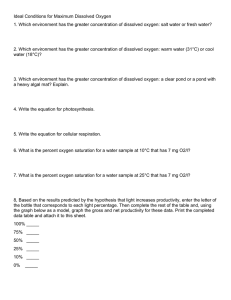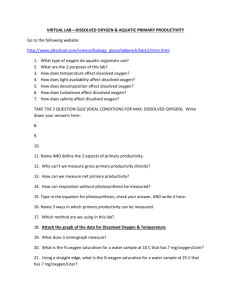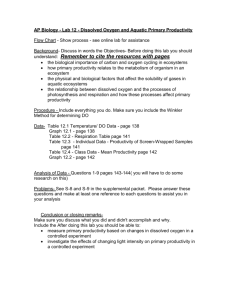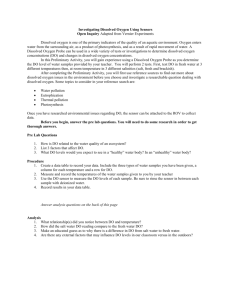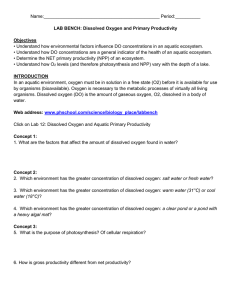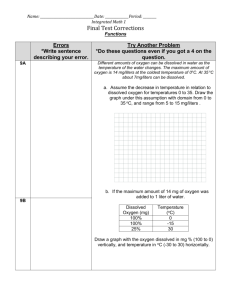What is photosynthesis? Photosynthesis II: Dissolved O 2
advertisement
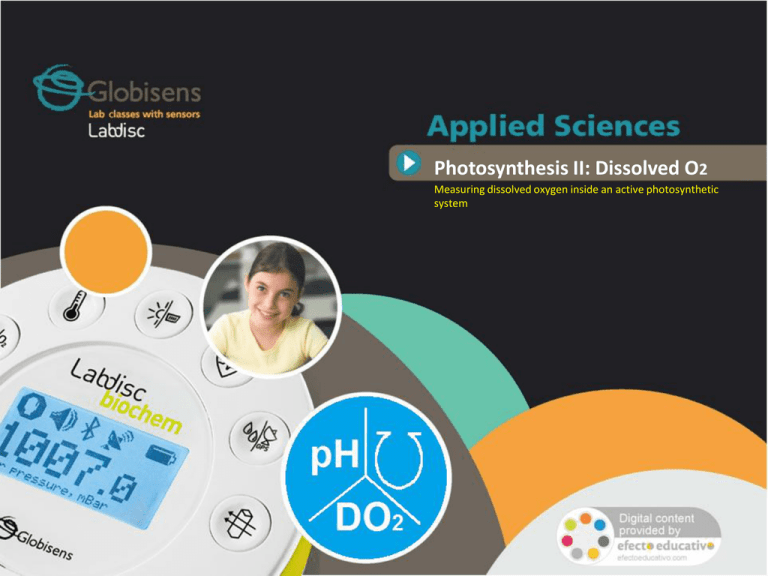
What is photosynthesis? Photosynthesis II: Dissolved O2 Measuring air dissolved oxygen inside an active photosynthetic Measuring pressure inside an active system photosynthetic system Photosynthesis II: Dissolved O2 Measuring dissolved oxygen inside an active photosynthetic system Objective The purpose of this activity is to study the dissolved oxygen variation within a photosynthetic system, creating a hypothesis and proceeding to test it using the Labdisc air pressure sensor. Photosynthesis II: Dissolved O2 Measuring dissolved oxygen inside an active photosynthetic system Introduction and theory Introduction The highly represented plant group produces its own food – basically glucose, a vital molecule for metabolic functions, oxygen from light energy, water and CO2. This kind of living being synthesizes these products by means of photosynthesis - its underlying survival mechanism. The environmental conditions such as intensity of illumination, carbon dioxide supply and temperature determine the rate of photosynthesis Photosynthesis II: Dissolved O2 Measuring dissolved oxygen inside an active photosynthetic system Introduction and theory How do you think environmental factors influence the rate of photosynthesis? How could we know the degree of importance of each environmental factor? Carry out the experiment activity with your class so that at the end you’ll be able to answer the following question. Is the intensity of light a crucial condition in the metabolic activity related to the photosynthetic rate? Photosynthesis II: Dissolved O2 Measuring dissolved oxygen inside an active photosynthetic system Introduction and theory Theoretical In aquatic environments dissolved oxygen is vital to the creatures that live there. The availability of this gas depends on the rate of photosynthesis, which is greatly determined by the intensity of light. Specifically, the light phase of photosynthesis is the moment when light dependent reactions take place, producing the molecular breakdown of water and the energetic transformation from light energy to chemical energy. Photosynthesis II: Dissolved O2 Measuring dissolved oxygen inside an active photosynthetic system Introduction and theory Now students are encouraged to raise a hypothesis which must be tested with an experiment. How is the dissolved oxygen availability modified by changing the light intensity? Photosynthesis II: Dissolved O2 Measuring dissolved oxygen inside an active photosynthetic system Activity description Students will measure the dissolved oxygen in a beaker when placing a photosynthetic organism inside. They will relate their observations to the results obtained during the experiment, and proceed to display their results in a chart for analysis. Photosynthesis II: Dissolved O2 Measuring dissolved oxygen inside an active photosynthetic system Resources and materials Labdisc Biochem 2 Dissolved oxygen electrode 4 Elodea canadiens aquatic plant (similar weight) 3 glass containers with screw cap (450 ml) Water Lamp (100 Watts) Photosynthesis II: Dissolved O2 Measuring dissolved oxygen inside an active photosynthetic system Using the Labdisc a. Labdisc configuration To collect measurements with the Labdisc dissolved oxygen and temperature sensors, the Labdisc must be set up by following these steps: Open the GlobiLab software and turn on the Labdisc . Click on the Bluetooth icon in the bottom right corner of the GlobiLab screen. Select the Labdisc you are using currently. Once the Labdisc has been recognized by the software, the icon will change from grey to blue . If you prefer a USB connection follow the previous instruction after clicking on the USB icon. You will see the same color change when the Labdisc is recognized . Photosynthesis II: Dissolved O2 Measuring dissolved oxygen inside an active photosynthetic system Using the Labdisc Click on to configure the Labdisc. Select external temperature and DO2 in the “Logger Setup” window. Enter “MANUAL” for RATE. Photosynthesis II: Dissolved O2 Measuring dissolved oxygen inside an active photosynthetic system Using the Labdisc Once you have finished the sensor configuration start measuring by clicking or pressing on the Labdisc. To collect the next samples press every time you take a new measurement.. Once you have finished measuring stop the Labdisc by clicking . Photosynthesis II: Dissolved O2 Measuring dissolved oxygen inside an active photosynthetic system Experiment The following steps explain how to perform the experiment: Fill one glass container with 250 ml of water at room temperature and measure the presence of dissolved oxygen and temperature as your first sample. To do this, take the probe, stirring the liquid slowly and continuously until the values on the Labdisc stay constant. Completely submerge three plants into three glass containers filled with 250 ml of water and close them. Photosynthesis II: Dissolved O2 Measuring dissolved oxygen inside an active photosynthetic system Experiment Expose two containers to the source of light, one at a distance of 15 cm and another at a distance of 20 cm for 10 minutes in a poorly illuminated room. Simultaneously, keep the third plant in a completely dark environment. Photosynthesis II: Dissolved O2 Measuring dissolved oxygen inside an active photosynthetic system Experiment After the ten minute period, shake the dark-exposed glass container, open the cap and measure the dissolved oxygen with the probe as in step 1. Repeat this procedure to measure the variables in each of the two glass containers, starting with the glass container closest to the light. Photosynthesis II: Dissolved O2 Measuring dissolved oxygen inside an active photosynthetic system Experiment Move the dark-exposed plant to light conditions and place the remaining plant into a glass. Renew the 250 ml of water in each case. Expose the two containers to the light source for 10 minutes, at distances of 25 cm and 30 cm respectively. Shake the containers, open the cap and measure the dissolved oxygen of both containers starting with the closest to the source of light. Photosynthesis II: Dissolved O2 Measuring dissolved oxygen inside an active photosynthetic system Results and analysis The following steps explain how to analyze the experiment results: Label the bars indicating the experimental conditions, the control, darkness or distances from the source of light. Use the tool from the GlobiLab software. Observe the table data clicking on to compare the values precisely and establish the differences between the measures. Photosynthesis II: Dissolved O2 Measuring dissolved oxygen inside an active photosynthetic system Results and analysis How do the results relate to your initial hypothesis? Explain. What was the relationship between the distance from the source of light and the dissolved oxygen measured? When did you record the minimum dissolved oxygen value? Did you expect this result? Why? Did you find differences between your controls: Only water and darkness? Photosynthesis II: Dissolved O2 Measuring dissolved oxygen inside an active photosynthetic system Results and analysis The graph below should be similar to the one the students came up with. Photosynthesis II: Dissolved O2 Measuring dissolved oxygen inside an active photosynthetic system Conclusions What variables are negatively correlated in this experiment? Why did this happen? Students should point out that the further the plants are placed from the light source, the lower the dissolved oxygen. As we learnt in the “What is Photosynthesis” reviewed at the beginning of this class, light is important in helping breakdown the water molecules over the light phase. One of the products from this reaction is oxygen, which was directly measured in the water. The distance from the source of light entails the variation of light intensity with the rate of photosynthesis increasing the closer the plant is to the light. Oxygen production, therefore, is proportional to the rate of photosynthesis. Why is it necessary to establish experimental controls? How would you interpret the results from these measurements? Students should indicate that the experimental controls allow us to know the real impact of the variables of interest in the obtained results. An experiment without controls will show confusing and questionable results. The control “only water” showed the basal concentration of dissolved oxygen in water. The control “darkness” showed the lower oxygen production due to lack of light; however it gave a higher value of dissolved oxygen than “only water” because of the presence of the plant. This means that there is a minimum oxygen production by the plant. Photosynthesis II: Dissolved O2 Measuring dissolved oxygen inside an active photosynthetic system Conclusions Considering the results obtained from the controls. Could you calculate the real production of oxygen due to light exposure? Students should calculate the effect of light intensity on the oxygen production, subtracting the control “darkness” to the magnitudes of dissolved oxygen on exposure to light. Thus, we clean the influence of oxygen presence by the volume of water and the basal production of plant. Photosynthesis II: Dissolved O2 Measuring dissolved oxygen inside an active photosynthetic system Activities for further application What other important environmental factor would you measure during the experiment? Why? Students could suggest measuring temperature, because they could have noted that the exposition time to the light slightly warmed the water. The temperature is also involved in the metabolic process of the plant, having a direct relation to the rate of photosynthesis Why can we find a greater diversity of fish and other aquatic animals in clear water rivers as compared to a swamp? Students should point out that the presence of fish and other aquatic animals – i.e. invertebrates – depend on oxygen availability, which is greatly produced by the aquatic plants. As we know, oxygen production requires light, which can be used by aquatic plants if turbidity or certain biotic or abiotic barriers do not prevent it from passing through the water. Additionally, the students could mention the natural aeration of water is better in turbulent water i.e. creeks and rivers.
